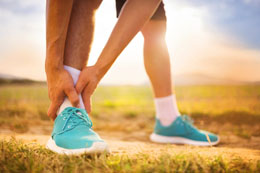This article covers some helpful tips on prevent ankle sprains - one of the most common medical complaints dealt by doctors. Keep reading...

Ankle sprains can affect any one, although it is highly associated with people who are involved in sports. The most common reason for the ankle to get sprained is its movement in an awkward manner. And such movements occur in the form of sudden twisting, rolling or turning of the ankle. There could be several situations which may result in the ankle getting sprained. Situations such as, you are walking or running on an uneven surface, or falling on your ankles. These actions may cause the ankle to twist suddenly and with a strong force thus, causing the sprain. It occurs when ligaments are forced to go beyond their normal range of motion, thus causing them to stretch too much or tear away.
Symptoms that Accompany Ankle Sprains
As obvious it is, the very first symptom would be a stinging pain that occurs immediately after the ankle injury has taken place. And if any sprain has occurred, then the pain would be soon followed by swelling and bruising. The affected ankle may be tender, warm and painful to touch. If you happen to hear any popping or cracking sound during the injury, and then you experience the above symptoms, you may suspect the sprain to be a severe one. It is important to know that, the severity of the pain and the swelling is directly proportional to the severity of the sprain and its recovery.
Healing and Preventing Ankle Injuries
Treating a sprained ankle involves three basic factors; rest, ice and elevation. Resting the sprained ankle buys time for the body to heal itself. However, complete inactivity may not do so good for the other muscles of the body. So it is necessary that while keeping the affected ankle at rest, the patient must workout the rest of the body. Coming to the use of ice, it is the most effective remedy for reducing pain and swelling of the ankles. Never apply ice directly to the skin, lest it may cause nerve damage. Wrap some ice cubes in a towel, and then apply the ice compresses, but not more than 15 - 20 minutes. Elevate the sprained ankle at a level higher than that of the heart. This prevents swelling. Besides these, it is also advisable for the patient to make use of splints, cane or crutches. And wearing elastic bandage on the affected part also helps in reducing swelling.
The prevention tips are as follows:
- One of the most effective tips to prevent your ankle from getting sprained is to wear well-fitting shoes, which should also provide enough support to the ankle area.
- As I have mentioned earlier, walking or running on uneven surface causes the ankle to move out of its normal position, thus twisting it and causing a sprain. So considering this, another method of reducing the chances of spraining your ankle is to simply avoid walking on such surfaces.
- Cases of ankle sprain in women is often a result of wearing high-heeled shoes. Such shoes cause the foot and ankle to move in a position that makes them to turn outward. And this is what causes loss of balance and eventually spraining the ankles. So avoiding such shoes may be a wise decision to make, especially if you are prone to ankle sprain.
- One beneficial tip for preventing foot and ankle injuries is to realize the kind of sports or activities which usually cause such problems. Your body may not be conditioned for such activities, thus avoid them. Look for alternative exercises or activities that you can carry out without risking any ankle injury.
- Ankle sprain could also result from the lack of warming up before workouts. So build a habit of stretching your muscles before going for any exercise, and the same post the workout.
- Get involved in stability training exercises. Such activities help your body to become more stable and reduce the risk of spraining the ankles.
So you see, the above preventive measures are not so difficult to follow and put into practice. Note that if your pain or swelling is getting too strong to be tolerated, consider it as a prime necessity to visit the doctor so that you can rule out potential problems.


 Ankle sprains can affect any one, although it is highly associated with people who are involved in sports. The most common reason for the ankle to get sprained is its movement in an awkward manner. And such movements occur in the form of sudden twisting, rolling or turning of the ankle. There could be several situations which may result in the ankle getting sprained. Situations such as, you are walking or running on an uneven surface, or falling on your ankles. These actions may cause the ankle to twist suddenly and with a strong force thus, causing the sprain. It occurs when ligaments are forced to go beyond their normal range of motion, thus causing them to stretch too much or tear away.
Ankle sprains can affect any one, although it is highly associated with people who are involved in sports. The most common reason for the ankle to get sprained is its movement in an awkward manner. And such movements occur in the form of sudden twisting, rolling or turning of the ankle. There could be several situations which may result in the ankle getting sprained. Situations such as, you are walking or running on an uneven surface, or falling on your ankles. These actions may cause the ankle to twist suddenly and with a strong force thus, causing the sprain. It occurs when ligaments are forced to go beyond their normal range of motion, thus causing them to stretch too much or tear away.